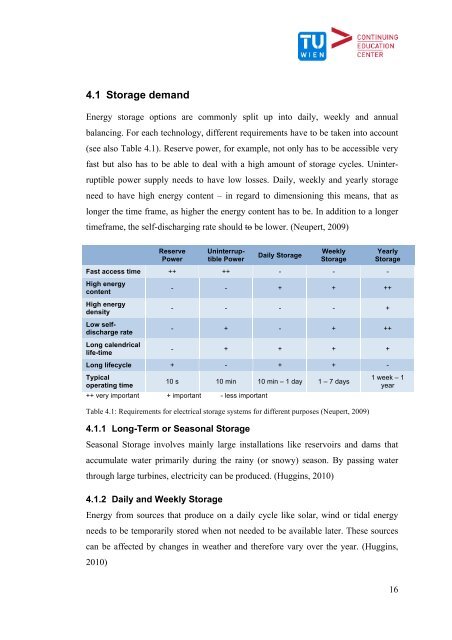The relevance of energy storages for an autarky of electricity supply ...
The relevance of energy storages for an autarky of electricity supply ...
The relevance of energy storages for an autarky of electricity supply ...
Create successful ePaper yourself
Turn your PDF publications into a flip-book with our unique Google optimized e-Paper software.
4.1 Storage dem<strong>an</strong>d<br />
Energy storage options are commonly split up into daily, weekly <strong>an</strong>d <strong>an</strong>nual<br />
bal<strong>an</strong>cing. For each technology, different requirements have to be taken into account<br />
(see also Table 4.1). Reserve power, <strong>for</strong> example, not only has to be accessible very<br />
fast but also has to be able to deal with a high amount <strong>of</strong> storage cycles. Uninter-<br />
ruptible power <strong>supply</strong> needs to have low losses. Daily, weekly <strong>an</strong>d yearly storage<br />
need to have high <strong>energy</strong> content – in regard to dimensioning this me<strong>an</strong>s, that as<br />
longer the time frame, as higher the <strong>energy</strong> content has to be. In addition to a longer<br />
timeframe, the self-discharging rate should to be lower. (Neupert, 2009)<br />
Reserve<br />
Power<br />
Uninterruptible<br />
Power<br />
Daily Storage<br />
Weekly<br />
Storage<br />
Yearly<br />
Storage<br />
Fast access time ++ ++ - - -<br />
High <strong>energy</strong><br />
content<br />
High <strong>energy</strong><br />
density<br />
Low selfdischarge<br />
rate<br />
Long calendrical<br />
life-time<br />
- - + + ++<br />
- - - - +<br />
- + - + ++<br />
- + + + +<br />
Long lifecycle + - + + -<br />
Typical<br />
operating time<br />
10 s 10 min 10 min – 1 day 1 – 7 days<br />
++ very import<strong>an</strong>t + import<strong>an</strong>t - less import<strong>an</strong>t<br />
Table 4.1: Requirements <strong>for</strong> electrical storage systems <strong>for</strong> different purposes (Neupert, 2009)<br />
4.1.1 Long-Term or Seasonal Storage<br />
1 week – 1<br />
year<br />
Seasonal Storage involves mainly large installations like reservoirs <strong>an</strong>d dams that<br />
accumulate water primarily during the rainy (or snowy) season. By passing water<br />
through large turbines, <strong>electricity</strong> c<strong>an</strong> be produced. (Huggins, 2010)<br />
4.1.2 Daily <strong>an</strong>d Weekly Storage<br />
Energy from sources that produce on a daily cycle like solar, wind or tidal <strong>energy</strong><br />
needs to be temporarily stored when not needed to be available later. <strong>The</strong>se sources<br />
c<strong>an</strong> be affected by ch<strong>an</strong>ges in weather <strong>an</strong>d there<strong>for</strong>e vary over the year. (Huggins,<br />
2010)<br />
16
















